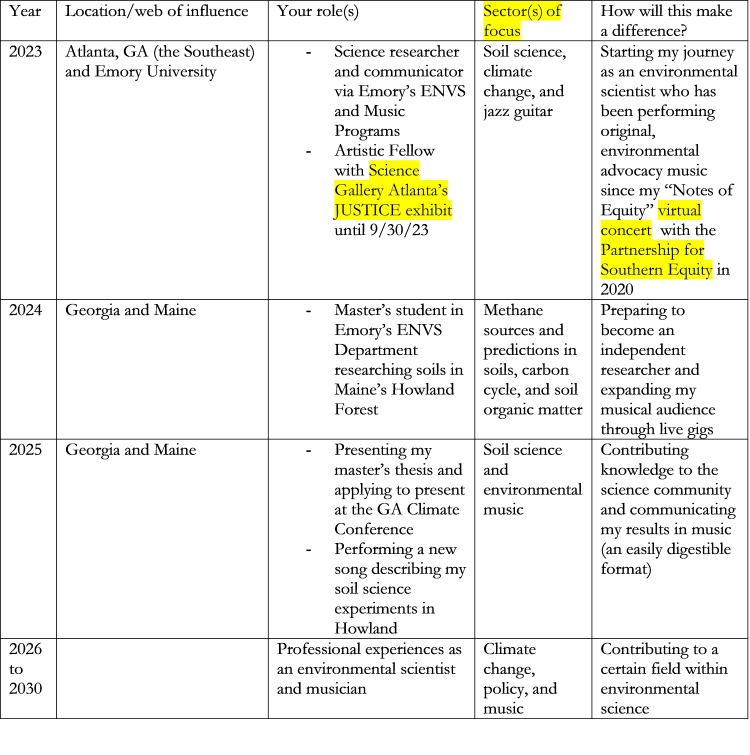As a grade school guitarist who loved both Taylor Swift and Steve Vai, I never guessed my future as a songwriter would lead through environmental science.
Yet, my professional path as a budding environmental researcher has supplied the inspiration for my music composed as an Emory student. I created songs related to my racial and environmental justice internship with a local Atlanta non-profit. I played at climate strikes on Emory’s campus and even won a global art contest at Georgia Tech. And my first virtual concert featured five original songs which served as the steppingstone for my climate advocacy projects. I am on my way to becoming a musical environmentalist.
The inspiration for many of my songs comes from hearing different stories from climate leaders. Last March, I traveled to New York for the Ceres Global Conference, a three-day business forum of businesspeople, politicians, and social leaders promoting a collective and sustainable course for the economy.
This diverse gathering reconfirmed my ambitions that a career in science research and communication through music is possible. It also reminded me that we have only seven years until 2030, based upon the Paris Climate Agreement, to limit our planet’s average temperature below 2 degrees Celsius of warming from pre-Industrial Revolution levels.
We need to enlist many more climate advocates as professionals and citizen scientists to meet these predicted and visible challenges. There’s no better time than today with growth in recruitment for climate-oriented careers and jobs. Climatebase, a global hiring and networking site, reports technical jobs connected to climate science are on the rise, according to the Bloomberg Green newsletter. Other related positions in business development, and marketing and communications are also in demand.
The U.S. Bureau of Labor Statistics projects positions for scientists and specialists will grow 8 percent this decade while trained technicians, such as for wind turbine service, will soar more than 50 percent.
On the airplane ride back to Atlanta, thoughts of my climate future ran through my head. I decided to map out a potential seven-year plan highlighting my steps to become a climate expert who communicates research and experiential findings through original songs. I share this blueprint, shown below, in hopes of encouraging other students and young climate professionals to chart their own courses.

- Science Gallery Atlanta’s JUSTICE exhibit
- Sector(s) of focus
- virtual concert
- Partnership for Southern Equity
This plan draws on a variety of climate-related experiences and interests. During my recent June fieldwork, I explored Howland Research Forest in Maine and absorbed all that I could from our project scientists. I came to love the bright, green Sphagnum moss and the coniferous forest that are critical in up-taking greenhouse gases like methane (CH4). Our goal is to better understand the factors that lead to the forest emitting and/or taking in methane. We aim to know how future conditions of a warmer and wetter climate will impact this vital Northern Forest.
My fieldwork led to plans for a new song about the vulnerability of future old-growth forests like Howland. In my second week, our team realized that a paper company was harvesting trees very soon – the land (including the soils below) that we were measuring. Our race against the clock has inspired the basis of my new tune.
The goal of my music and research is to give the public the sense of urgency and empathy needed to restore the beauty of our planet. Through art, we can build community among our common struggles within the Anthropocene. A place like Science Gallery Atlanta is a prime example of how art and science are not only intertwined but produced to inform and inspire the public.
This past semester, I became an Environment & Art Sessions for Emerging Leaders (EASEL) Fellow with this gallery and ELND. My work, along with three other student artists, will be on display in the JUSTICE exhibit through the end of September 2023.
“Shadow (on Earth),” the song composed for this exhibit, is dedicated to my Grandma Zora R. Kahn who passed away in 2007. My song discusses the world that my grandmother left and the world that I live in now. The environmental disasters that happened in 2007 continue to happen to this day but at a more extreme rate due to anthropogenic forcing.
Now that my grandmother has been gone for over a decade, it is my turn to take on the responsibility of addressing the injustices that we still face. As “her shadow,” my childhood nickname, I hope to inspire others to act for the climate and society- because “nothing else matters if we can’t save our planet.”